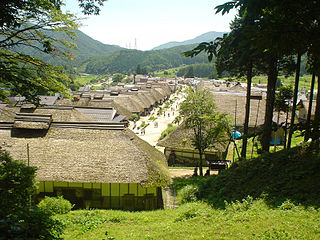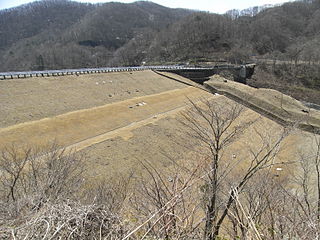Graphs are unavailable due to technical issues. There is more info on Phabricator and on MediaWiki.org. |
The following is a list of dams in Fukushima Prefecture, Japan.
Graphs are unavailable due to technical issues. There is more info on Phabricator and on MediaWiki.org. |
The following is a list of dams in Fukushima Prefecture, Japan.

Fukushima is the capital city of Fukushima Prefecture, Japan. It is located in the northern part of the Nakadōri, central region of the prefecture. As of 1 August 2023, the city had an estimated population of 275,850 in 122,130 households and a population density of 359 inhabitants per square kilometre (930/sq mi). The total area of the city is 767.72 square kilometres (296.42 sq mi).

Fukushima Prefecture is a prefecture of Japan located in the Tōhoku region of Honshu. Fukushima Prefecture has a population of 1,771,100 and has a geographic area of 13,783.90 square kilometres (5,321.99 sq mi). Fukushima Prefecture borders Miyagi Prefecture and Yamagata Prefecture to the north, Niigata Prefecture to the west, Gunma Prefecture to the southwest, and Tochigi Prefecture and Ibaraki Prefecture to the south.

Sukagawa is a city located in Fukushima Prefecture, Japan. As of 1 May 2018, the city had an estimated population of 76,251 in 38824 households, and a population density of 270 persons per km2. The total area of the city was 279.43 square kilometres (107.9 sq mi).

Shimogō is a town located in Fukushima Prefecture, Japan. As of 1 April 2020, the town had an estimated population of 5,517 in 2216 households and a population density of 17 persons per km2. The total area of the town was 317.04 square kilometres (122.41 sq mi).

Hinoemata is a village located in Fukushima Prefecture, Japan. As of 1 January 2020, the village had an estimated population of 556, and a population density of 1.5 persons per km². The total area of the village was 390.46 square kilometres (150.76 sq mi). It is locally famous for its soba and known nationally for its kabuki performances and as a gateway to the Oze marshlands.

Tadami is a town located in Fukushima Prefecture, Japan. As of 1 March 2020, the town has an estimated population of 4,117 in 1749 households, of which 45.88% were classified as "elderly households" The town had a population density of 5.5 persons per km2. The total area of the town was 747.56 square kilometres (288.63 sq mi). Tadami is famous locally for its own Snow Festival, where huge sculptures and replicas of monuments are cut out of Tadami's abundant snow.

Mishima is a town located in Fukushima Prefecture, Japan. As of 1 March 2020, the town had an estimated population of 1,590 in 755 households, and a population density of 18 persons per square kilometre. The total area of the town was 90.81 square kilometres (35.06 sq mi). In 2017, Mishima was selected as one of The Most Beautiful Villages in Japan.

Nishigō is a village located in Fukushima Prefecture, Japan. As of 1 March 2020, the village had an estimated population of 20,351 in 7618 households and a population density of 110 persons per km2. The total area of the village was 192.06 square kilometres (74.15 sq mi)..

The Tone River is a river in the Kantō region of Japan. It is 322 kilometers (200 mi) in length and has a drainage area of 16,840 square kilometers (6,500 sq mi). It is nicknamed Bandō Tarō ; Bandō is an obsolete alias of the Kantō Region, and Tarō is a popular given name for an oldest son. It is regarded as one of the "Three Greatest Rivers" of Japan, the others being the Yoshino in Shikoku and the Chikugo in Kyūshū.

Asahi Dam (旭ダム) is a dam in Shimogō, Fukushima Prefecture, Japan, completed in 1935.

Hatori Dam is a dam in Ten'ei, Fukushima Prefecture, Japan. Hatori Dam is managed directly by the Ministry of Agriculture, Forestry and Fisheries, and is intended to provide irrigation for the Shirakawa area of the Abukuma River Basin. The dam is an earth dam with a height of 37.1 meters. The reservoir created by the dam is called Lake Hatori, and has been developed as a resort area.

Yamasato Dam is a dam in the Fukushima Prefecture of Japan, completed in 1943.